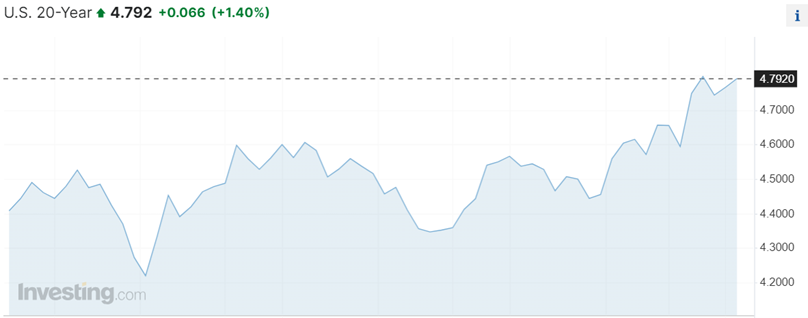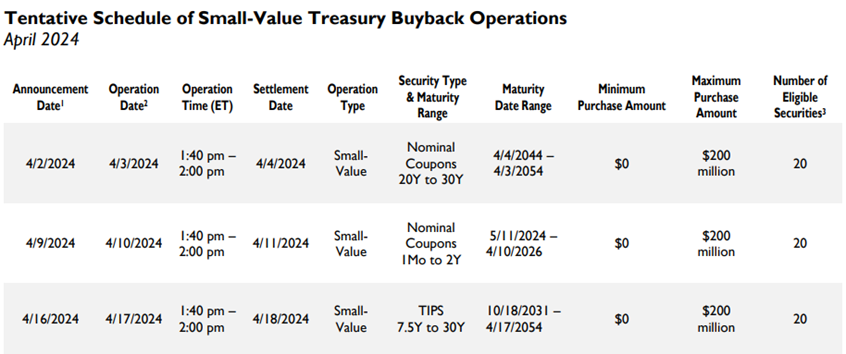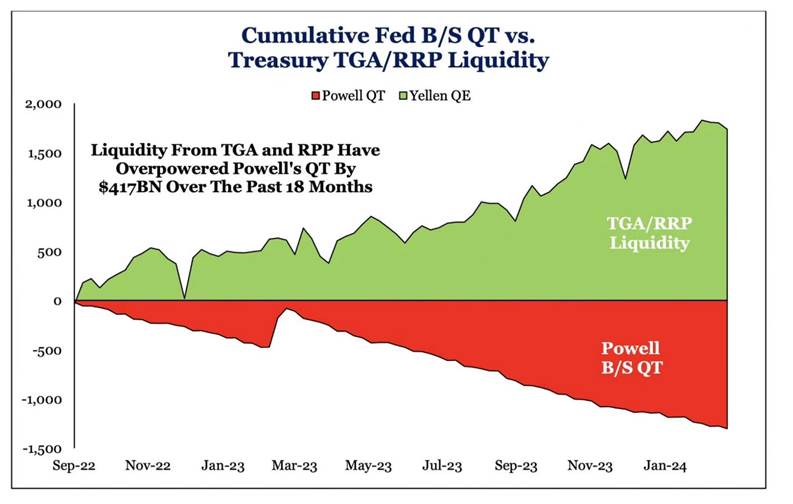US Treasury Buyback: Could This Decades-Unseen Plan Bolster Treasury Prices?
In recent months, strong U.S. employment and inflation data have delayed expectations of a rate cut by the Federal Reserve, pushing U.S. bond prices down and interest rates continuing to soar. As of the last trading day, the 20-year Treasury bond yield reached 4.792%, and the 30-year Treasury bond yield reached 4.668%.
The Treasury Department's latest bond buyback plan has sparked discussion about whether it could bolster bond prices.

In early April, the U.S. Treasury Department conducted its first bond buyback since the year 2000. The buyback targeted Bonds with maturity dates between May 15, 2044, and February 15, 2054 (20-year to 30-year maturities), with a scale of $200 million. The process of establishing and justifying this buyback plan took almost a year. It is worth mentioning, as stated in the Treasury's announcement, that the scale of this first buyback was 'conservative.'

According to the buyback plan disclosed in August last year, the Treasury Department will regularly purchase two types of securities at a maximum of $30 billion/quarter (up to $120 billion/year):
(I) Nominal rate bonds (Bonds & Notes) of varying maturities from 0 to 30 years.
(II) Treasury Inflation-Protected Securities (TIPS) in two maturity categories: 0-7.5 years and7.5-30 years.
UBS strategist Michael Cloherty noted the Treasury would announce a full launch to the program in May.The Treasury Department suggests that they will conduct one to two buybacks per quarter for each type of security, which implies that there could be operations taking place every week.
■ Is the buyback plan feasible?
Currently, the balance of the TGA (Treasury General Account) is about 800 billion US dollars (far exceeding the pre-Covid level). Considering that one to two hundred billion in cash will be received by the tax filing deadline on April 18, the Treasury Department will have sufficient fiscal resources to support this buyback plan in the future.

■ The Treasury's last buyback dates back to the year 2000.
This is not the first time the Treasury has proposed a buyback plan. On January 13, 2000, Treasury Secretary Summers announced that within the year, the Treasury would repurchase up to $30 billion of federal debt held by the public. The purpose of the repurchase was to enhance liquidity in the bond market and cash management, as well as to prevent the potential for costly and unreasonable growth in U.S. debt.
At that time, the round of the internet and technology revolution in the late '90s had propelled the U.S. economy to rapid growth, with a booming stock market and the long-missed appearance of a "surplus" in fiscal balance. Summers stated, "When tax revenues exceed immediate spending needs, debt repurchase is an effective use of excess cash."

According to the Treasury Department's report, in the two preceding years (1998-99), the U.S. had repaid a record $140 billion in debt and successfully kept the total government debt (approximately $5.8 trillion) below the 1993 levels (the start of Clinton's term) by $1.7 trillion. Additionally, interest expenses for 1999 were $91 billion below the budget. At the end of the Federal Reserve's interest rate hikes, the Treasury's buyback operations effectively lowered long-term interest rates and successfully delayed the exposure of certain massive asset bubble risks — until the end of Clinton's administration.
■ What are the implications now?
1. From the perspective of economic effects, the Treasury issuing "high-priced" bonds and repurchasing "low-priced" bonds is akin to public companies issuing additional shares when the price-to-earnings ratio (P/E) is high and repurchasing and canceling them when the P/E is low. This operation is equivalent to selling high and buying low.
Nearly 40% of the old debt was issued at interest rates below 2%, and over 70% was issued at rates below 3%. Since the current long bond yield exceeds 4.5%, the prices of the aforementioned old bonds have generally been significantly discounted.
2. Secondly, Bond buyback plans help the Treasury to smooth out the new supply of Treasury Bills under the total constraint of the debt ceiling. Especially since the U.S. government restarted bond issuance in the second half of 2023, the Treasury has significantly increased the issuance proportion of short-term Bills to swap out the continuously maturing Notes and Bonds in the high-interest-rate environment, significantly exacerbating the inversion of the yield curve.
The buyback plan will not only push down long-term bond yields, but may also make the yield curve less inverted.
If combined with the reverse twist operation proposed by Federal Reserve official Waller at the beginning of last month (i.e., the Fed buying short-term Treasury bills without expanding the size of its assets and reducing the holdings of MBS), it would ensure the smooth issuance of the Treasury's short-term debt while suppressing short-term interest rates.
However, UBS's Cloherty cautions against overly optimistic expectations regarding the impact. He noted being long 20s is fine for someone with a one-month or shorter horizon, since many investors seem to be so in need of structural trade ideas that the buyback impact on 20s should draw a lot of interest. Nevertheless, the market's expectation is that the Treasury will buy each of its nine buckets twice per quarter. Unless the liquidity shock hits right before a buyback, it will be too far away for dealers/others to hold illiquid paper while waiting for the buyback.
He noted that if 20s cheapen sharply on the day before the Treasury is scheduled to buy up to $2bn in the 10yr to 20yr bucket, there will be significant support from the 20yr purchase. But if the next 10yr to 20yr purchase is six or seven weeks away, that is far too long for dealers to feel comfortable holding illiquid paper in the middle of a liquidity shock. At those times the Treasury buyback support for 20s will be minimal. This suggests a sharp seasonal pattern in 20yr liquidity risks to develop once the buyback program starts.
“If the Tsy buys each bucket two times per quarter, no one is likely to be particularly keen to hold an illiquid issue when the next buyback might be seven weeks away.” Cloherty said.
Disclaimer: Moomoo Technologies Inc. is providing this content for information and educational use only.
Read more
Comment
Sign in to post a comment

SpyderCall : Great read.

104114366 : zlzzzzlzlx lo pzpPzzzzpp
1000proof : Great information
FearGreed : Yield curve control?